Cough remain as untreated and symptoms of multiple disease. Cough remains a serious unmet clinical problem, both as a symptom of a range of other conditions such as asthma, chronic obstructive pulmonary disease, gastro oesophageal reflux, and as a problem in its own right in patients with chronic cough of unknown origin. Cough remains a major unmet medical need and, although the centrally acting opioids have remained the antitussive drug of choice for decades, such opioids possess many unwanted side-effects. Now a days the synthetic and novel drugs are the major source of curing any type of disease, although these chemically synthesized drugs are harmful hazardous and shows toxic effect on the human body, this research formulation is a Polyherbal product which is useful and effective to treat the acute as well as chronic cough mainly chronic cough in patients of all ages. The prolonged chronic cough which lasts for several months or even years (in some patients) so to treat this “Polyherbal anti-tussive syrup” is best mode, this syrup consists of some prominent and effective naturally occurring drugs or medicinal plants like, cinnamon, clove, black paper, Tulsi, honey (as base), and menthol (as cooling agent expectorants). This particulate combination of drugs is very effective for the treatment of cough, although this syrup can also be used for the treatment of the common cold respiratory disorders or nasal problems.
Anti-tussive, Medicinal Plants, Polyherbal Formulation, Expectorants, Cough Syrup, phytochemicals.
Nature has been a source of medicinal agents for thousands of years, and an impressive number of modern drugs have been isolated from natural sources, particularly plants and with many based on their use in traditional medicine. By using medicinal chemistry and combinatorial chemical and biosynthetic technology, novel natural product needs will be optimized on the basis of their biological activities to yield effective chemotherapeutic and other bioactive agents. (17) ) During the past decades, public interest in natural therapies, namely herbal medicine, has increased dramatically not only in developing countries but mainly in industrialized countries. Cough associated with the acute and chronic conditions is commonly in patients of all ages, common cause of cough are bacterial or viral infection on the upper respiratory tract, air pollution cigarette smoking, foreign body, asthma and eosinophilia bronchitis. Only controlling the ethology of cough may not be effective treatment but also addition of desensitizing of cough pathways is also essential. Treatment of cough depends on function the cough is serving, when cough indicates an under an underlying illness but treatment should also attempt to control, prevent or eliminate using the cough suppressive agents. In these situations the use of expectorants and anti-tussive agents are indicated not only to alleviate the cough but also to eliminate the more serious events occurring.(19)
During the past decades, public interest in natural therapies, namely herbal medicine, has increased dramatically not only in developing countries but mainly in industrialized countries. In this poly herbal anti- tussive syrup formulation containing some of the natural drugs like Clove (Eugenia aromatica), Cinnamon (Cinnamomum cassia), Black pepper (Piper nigrum), Tulsi (Ocimum sanctum), peppermint (menthol) & Honey (as a base) were formulated and evaluated. These particulate combinations of natural drugs which have cough repellent property are made in form of syrup. These are nontoxic not harmful does not show any of side effect on human body and most superior than of OTC drugs. (18) Herbal cough syrups provide a natural alternative to conventional cough medications. They are formulated using a variety of medicinal herbs that are believed to have expectorant, soothing, and antitussive properties. These syrups are commonly used to relief cough symptoms associated with the common cold, bronchitis, and other respiratory disorders. (17)
Cough
Coughing is a basic physiological reaction to respiratory tract irritation that helps to keep the airway free and safe. While coughing is a deliberate response, it is also a common involuntary indication of respiratory infection in otherwise healthy persons. Numerous respiratory pathogens, including bacteria, fungi, and viruses, have developed virulence pathways to cause both acute and long-term infections in the respiratory mucosa. Cough may result from direct interactions between these viruses or their microbiological components and the intricate pulmonary neural networks 4-6. The host immunological response to the infection causes considerable cellular infiltration and the generation of inflammatory signals in addition to the direct infection of immune cells and pulmonary epithelia. (1)
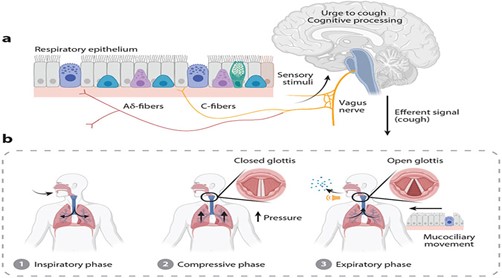
Physiology of cough
In response to stimuli that irritate the respiratory tract, airway sensory neurons innervate the respiratory epithelium. The vagus nerve transmits sensory impulses to the brainstem, which encodes the urge to cough. Coughing starts as a function of the subsequent cognitive processes. In the inspiratory ph2ase of a cough, expiratory muscle lengthening and air inhalation occur first. The next step in the compressive phase is to raise intrathoracic pressure by briefly closing the glottis. Ultimately, during the expiratory phase, the glottis opens, releasing air quickly and creating the distinctive cough sound while also promoting mucociliary movement.(1)
Table1: Herbs used in preparation of polyherbal anti-tussive
Polyherbal anti-tussive syrup formulation containing some of the natural drugs like Clove (Eugenia aromatica). Cinnamon (Cinnamomum cassia), Black pepper (Piper nigrum), Tulsi (Ocimum sanctum), Peppermint (menthol) &Honey (as a base) were formulated and evaluated. These particulate combinations of natural drugs which have cough repellent property are made in form of syrup. (7)
Clove
Ripped dried flower of Clove (Eugenia aromatica) was used. These are easily available in the market in the dried form but it requires drying in sun light for nearly 4 to 5 hrs. Then nearly 30 to 40 g of dried clove was taken for formulation purpose. (10)
Cinnamon
Ripped dried bark of cinnamon (Cinnamomum cassia) was used. These are also easily available in market in dried form it also requires a sun light drying for removal of total moisture. Then nearly 20 to 30g of the cinnamon was taken for the formulation. (10)
Black pepper
Dried ripped fruit part of black paper (Piper nigrum) was used. These are small black coloured bean shaped cleaned and cleared. These are also available in market like other drugs. Nearly 10- 15g of drug was taken for formulation.(10)
Tulsi
Fresh plucked leaves of Tulsi was used which should be weighed nearly 20-25g was taken for formulation.(10)
Peppermint oil
Peppermint oil which are easily available in the market, and nearly 1-2ml was taken for formulation.(10)
Preparation method for Syrup:
Preparation of drug powder
The required amount of each dried crude drug (clove, cinnamon, black paper) about 20-40g, was taken and crushed into fine powder using the mortar and pestle, each drug was powdered separately, then each drug was collected in separate vessel and weighed, each drug should full fill the required amount. Clove and cinnamon should weigh nearly 20-40g and black paper nearly 10- 15g.
Extraction by maceration
Each powdered drug was taken for the process of maceration, Each drug is socked separately in different beaker containing 400-500ml of distilled water, or slightly alcohol treated water nearly 5% alcohol (2-4ml alcohol in 100ml water). The adequate amount of water was added that means 13-14 times the quantity of drug, and then these beakers were put for nearly 17-24 hours for undisturbed condition.
Extraction of clove oil
Steam distillation assembly was set up for extraction of clove oil. About 30-40 g powdered cloves taken into round bottom flask and refluxed for 1-2 hours, and oil is extracted.
Table 2: Amount Of Herbs Used In Herbal Syrup
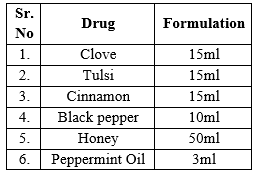
Preparation of Tulsi leaves decoction
Firstly, the fresh green leaves of Tulsi should weigh nearly 30-40g was taken and washed and cleaned properly and added in a beaker and soaked with 400-500ml distilled water (nearly 3-4 times more quantity of drug), then kept aside undisturbed for nearly 4-5 hours, then after 4-5 hours boiled it until the quantity of water remain less than small portion or one third of original nearly 20-25 ml. Then it was taken and filtered with filter paper and stored well.
Preparation decoction of macerated drugs
The powdered drugs which were macerated earlier collected and boiled separately at constant temperature for 1-1.5 hour, up to when the quantity of water remains less than small portion or one third original nearly 10-20ml, then decoction was filtered with muslin cloth and stored separately.
Preparation of final poly herbal syrup
In a of 100ml beaker nearly 50ml of honey was taken as the honey is itself syrup so no need to prepare any syrup as it is a drug constituent as well as the syrup, then it was kept aside. Then the prepared decoction of all drug constituents (which should be as clove-15ml, cinnamon-15ml, Tulsi-15ml, black paper-10ml) was taken and mixed well. And while mixing nearly 1- 2ml of peppermint oil was added. Finally, the prepared mixture was added in the beaker containing the honey, and then the mixture was shaken to produce one phase, and kept for stabilization. Lastly final volume of syrup was made up to 100ml with the water.
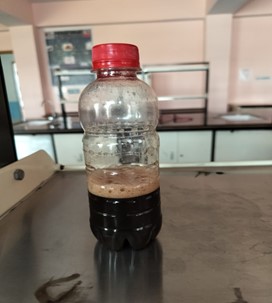
Fig.2 Polyherbal Antitussive Syrup
Evaluation test for the poly herbal syrup
Physiochemical parameters of syrup
The herbal syrup was evaluated for various physicochemical parameters such as physical appearance (colour, odour, taste), pH, Density and Specific Gravity.
Colour Examination
Five ml final syrup was taken into watch Glass and placed against white back ground in white tube light. It was observed for its colour by naked eye.
Odour examination
Two ml of final syrup was smelled individually. The time interval among two smelling was kept 2 minutes to nullify the effect of previous smelling.
Determination of pH
Placed an accurately measured amount 10 ml of the final syrup in a 100 ml volumetric flask and made up the volume up to 100 ml with distilled water. The solution was mixed for about 10 minutes in magnetic stirrer. PH was measured with the help of digital pH meter.
Specific gravity
A thoroughly cleaned and dry Pycnometer was selected and calibrated by filling it with recently boiled and cooled water at 25°C and weighing the contents. The capacity of the Pycnometer was calculated. Adjusting the temperature of the final syrup to about 20°C and the Pycnometer was filled with it. Then the temperature of the filled Pycnometer was adjusted to 25°C any excess syrup was removed and weight was taken. The tare weight of the Pycnometer was subtracted from the filled weight. The weight per ml was determined by dividing the weight in air, expressed in g, of the quantity of syrup which fills the Pycnometer at the specified temperature, by the capacity expressed in ml, of the Pycnometer at the same temperature.
Specific gravity of liquid= Mass of liquid/ Mass of equal volume of water
Determination of Density
Density of the syrup was determined by using the density bottle method by measuring the weight and the volume, by the density bottle average density was found to be 1.43g/ml.
Determining the viscosity of syrup
The viscosity of the syrup was determined by using Ostwald’s viscometer. The viscometer is cleaned and mounted on suitable stand. Fill the viscometer upto mark A. Count time taken for water to reach from A to B. Repeat same procedure for syrup.
RESULTS AND DISCUSSION
Physiochemical parameters of syrup the physiochemical parameters such as colour, odour, taste pH, density, specific gravity viscosity of syrup were performed. The evaluation parameters results were listed in Table -3. The prepared Poly herbal anti-tussive syrup is Brownish red, sweet in taste with neutral pH & having good pour ability.


 Kiran Kumari*
Kiran Kumari*

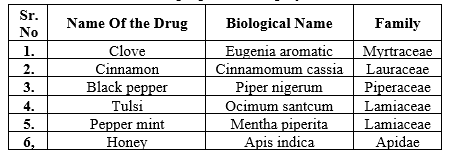


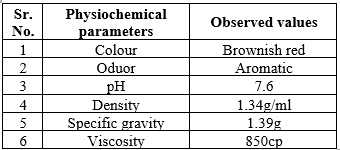
 10.5281/zenodo.11221410
10.5281/zenodo.11221410